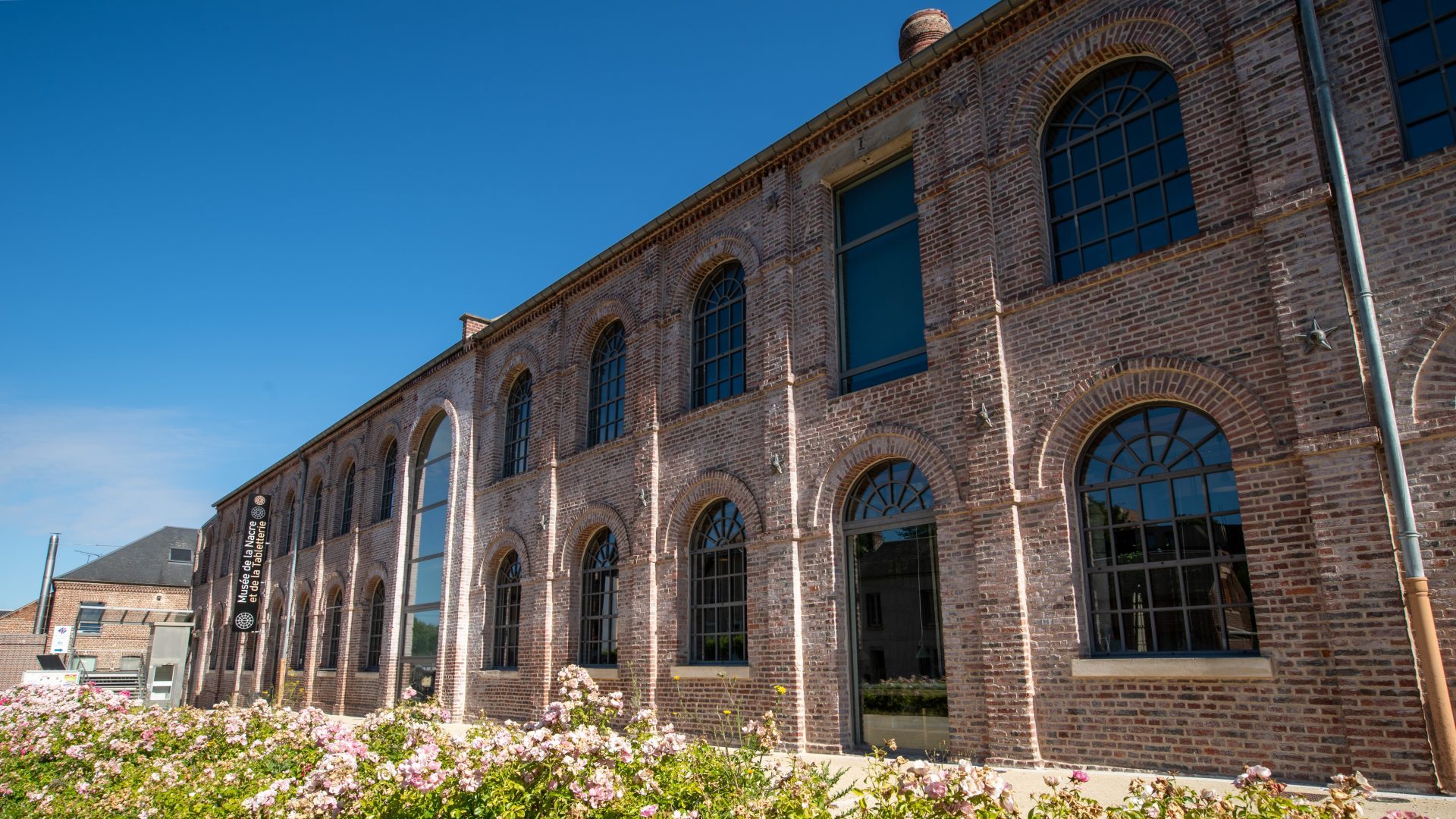It was a surprising, if fitting coincidence that I was shown the way to the Museum of Nacre and Tabletterie by a gentleman from Madagascar. On my arrival at Méru train station, Hauts-de-France, he pointed out the brick façade and chimney of the building, a former button factory, easily visible on the wooded hillside above the town, and told me to go straight ahead.
Inside were baskets of shell and nacre, also known as mother of pearl – the shiny and strong mineral molluscs like oysters produce to coat the inside of their shells. The contents have been brought from far-flung parts of the world – including Madagascar – to Méru in the years when its factories used them to produce buttons and other small objects like dominos and dice, referred to as tabletterie.
The Museum of Nacre and Tabletterie is an unusual find, a record of a trade long forgotten in an age of mechanisation. It opened in May 1999, following the efforts of a group of local enthusiasts committed to safeguarding the vanishing heritage of the craft. Ever since, it has welcomed on average 20,000 visitors a year.
The museum tour begins with a question: “What is tabletterie?” None of us know. Our guide describes how the term originated in the middle ages, when the first craftsmen made wooden tablets coated with wax to write on; these became associated with religious rites and were later realised in precious materials. In Méru, tabletterie started off as a cottage industry in the 1700s. During the winter months, farmers worked at home hand-carving a range of items that included knife handles and combs, crucifixes, small boxes and cases and the sticks and guards of folding fans from bone, horn and wood.
The trade expanded and flourished in the 19th century with the introduction of button-making, facilitated by the advent of steam-powered machinery. At its height, in 1910, as many as 10,000 workers were employed in the region’s button factories.
“Although the industry was very local,” explains the museum guide, “the raw materials were coming from all across the world”. Shipments arrived at Le Havre to be transported to Hauts-de-France, while the finished product was sent to grand couture houses and department stores in Paris and exported to Europe, Africa and America.
But, as with other manufacturing industries of this type, survival in the 20th century proved more challenging, with competition from overseas, two world wars, the economic crash of the 1930s, the rise of plastic and other synthetics in the 1960s and the prohibition of international trade in endangered species from the 1970s onwards. Decline and closure seemed inevitable and Méru’s button-making and tabletterie tradition might have vanished altogether had it not been for the families whose connection to it was rooted in generations.
Pierre Planson comes from one such family and today gives occasional talks at the museum. When he was 13, his grandfather, a button-maker, encouraged him to learn to cut mother of pearl and Pierre became employed at a factory in nearby Amblainville, working his way up to director in 1976.
When the factory closed 25 years later, Planson donated some of the machinery to the museum. Others collected photographs, tools and oral histories, all of which contribute to the patrimoine, the shared intangible heritage of local people, who were involved in making the same objects using the same techniques and materials, preserved and on display here.
On the ground floor is a reconstruction of Monsieur Tatin’s domino-making workshop showing sections of cow bones imported from Latin America and slabs of ebony from Africa. Once the bone and ebony were cut into shape and fused together using a fish glue to make a domino bar, smooth and pleasant to hold in the hand, its centre was marked with a brass tack on the upper white (bone) layer and pierced with a row of shallow holes, which were then inked up. The process engaged the whole family, from grandparents to grandchildren, everyone working at home and, according to our guide, their speed and accuracy could not be matched by any machine.
The larger part of the ground floor is given over to button-making, which took place in factories. To my 21st-century eyes, I’m impressed by the size of the steam engine that powered the machines, shaping, polishing and drilling. The guide switches the engine on and its rapid whirr accompanies a demonstration of holing buttons.
The museum workrooms are scattered with the remains of gleaming iridescent shell, incongruous-looking among the heavy, ungainly, iron machinery and drifting dust. Our guide tells us that, in cutting the shell for buttons, as much as 70% was wasted and discarded, to be used as fertiliser in the surrounding fields or as building material in garden paths.
The dust also caused respiratory illnesses, but to the children who grew up in the factory, it was an Aladdin’s cave of marvellous treasures. Roger Langlois remembers playing among the exotic seashells and the pleasure of putting one close to his ear and listening to distant seas. Nor is the magic confined to the fantasies of children: “The dyeing of buttons was extremely secret,” says our guide. “Even today we don’t know the precise recipes they used to colour them. It was almost a magic formula.”
Upstairs, a suite of galleries explores the provenance of the raw materials and the products of tabletterie, from games of dominos and tiddlywinks to a collection of exquisite folding fans. The history of games, like the materials they were made from, is global, too: dominos were said to have originated in China and chess in Persia; games using dice were known in Ancient Greece and Egypt.
There is scant investigation here, however, into the local economies and overseas workforce who harvested the raw materials later shipped to France for manufacturing. One exception is a small section covering the free divers or “Sea Sama” in the Philippines, who lived on houseboats and dived to depths of 45 metres or more to collect Pinctada maxima oysters for their pearls, remaining underwater for up to three minutes without oxygen tanks. It sounds like strenuous, dangerous work in the pursuit of beauty and profit.
Ultimately, the invention of deep-sea breathing equipment enabled greater quantities to be gathered, with the consequent decline in numbers. This, alongside the development of pearl farms, reduced the need for free-divers. Today, ocean acidification, warming temperatures and pollution impact pearl farmers in this part of the world.
The Museum of Nacre and Tabletterie’s collections continue to expand. Recent acquisitions include a 19th-century showcase of 123 ivory and nacre objects worked by the Devarenne family, father and son, as an advertisement of their skills. In another case are paper knives, nutcrackers and curtain rings (purchased 2017); then there is a collection of Henri Hamm art nouveau buttons (purchased 2019) and the acquisition of an entire museum of 3,000 fans, paper designs, tools and materials belonging to Anne Hoguet in Paris, a vast collection rescued from being broken up in February 2023.
This “living museum” also employs four staff in its ateliers; two make sets of dominos, one restores and creates decorative objects and another is a button-maker, whose training is in cabinet-making and who learnt button-making at the museum under the tuition of former factory workers. These artisans take on private commissions, although many are restoration projects: repairing the sticks of a folding fan or replacing the missing piece in a board game or gem in a ring. They use the considerable stock of left-over nacre and seashell in the museum to make their products, which are sold in its vibrant shop.
I was tempted by a set of exquisite mother-of-pearl buttons sewn on to card and some hairslides, but chose a bird pendant carved from corozo, a material I had come across in a display upstairs. For those with deeper pockets, there are boxes of shimmering dominos of ebony and nacre and bijou dice that will bring a sparkle to any game.
The museum shows us the value of work through the employees who found fulfilment when it was a factory, taking pride in their part in the manufacturing process, despite its physical demands. It also demonstrates the range of skills required to create a world in a tiny button, making something both useful and beautiful.
In one room, there is a quote from Christian Dior on the wall: “Le detail est aussi important que l’essentiel. Quand il est malheureux, il detruit tout l’ensemble.” It means: “The detail is as important as the whole. When it is ill-conceived, it destroys the ensemble.”
Le Musée de la Nacre et de la Tabletterie, at 51 rue Roger Salengro, 60110 Méru, France is open every day except Tuesday. Details: musee-nacre.fr











